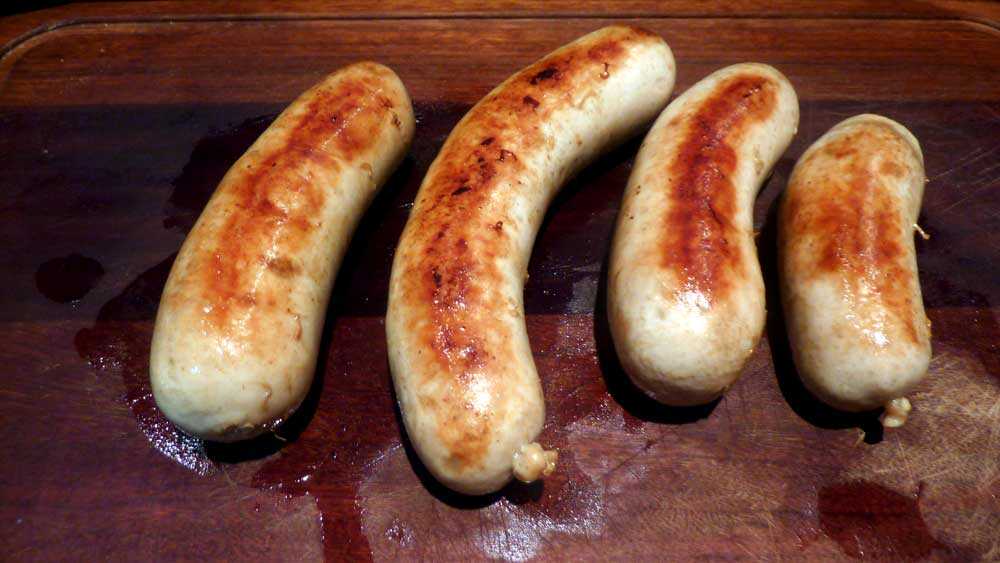
As salsichas alemãs são famosas pela excelência na produção e diversidade de receitas. A salsicha Bratwurst é um tipo de salsicha alemã feita de vitela, carne bovina e/ou suína. O nome provém em alemão de Brätwurst, brät(cortada finamente) e Wurst(salsicha), embora atualmente o entendimento faça também referência ao verbo braten, que significa frito ou assado.
É importante ler esse texto introdutório antes de partir para a receita pois o segredo da salsicha está nos detalhes do processo e não na receita! Sem ler e reler o processo, preferencialmente de diferentes fontes, tentar, errar e perseverar, dificilmente alguém fará uma salsicha boa.
Fazer salsicha em casa é um desafio muitas vezes frustrante, principalmente no início, primeiramente pelo fato da necessidade de certo controle sobre as temperaturas durante a produção, em segundo por exigir potência do processador de alimentos utilizado e em terceiro pela dificuldade de embutir a massa emulsionada que é bem mais mole do que a de uma linguiça. Não é necessário um moedor de carne, pois é possível deixar todo o trabalho para o processador, mas a moagem pode facilitar o processamento. No caso não usei moedor, apenas piquei a carne e coloquei no processador, que, apesar do calor gerado, mostrou-se heroico ao executar a tarefa. Detalhe importante: as lâminas de corte do processador devem estar muito bem afiadas!
Toda salsicha é o que comumente chamam de uma emulsão carnea ou, mais detalhadamente, uma mistura uniforme estabilizada de água, gordura e proteína. A estabilidade dessa mistura depende de uma boa fonte de proteína e temperatura baixa. O leite em pó também ajuda a estabilizar a massa. Caso a temperatura suba durante o preparo a gordura irá derreter e a emulsão irá desandar. A gordura empregada deve ser firme, rígida, preferencialmente da região subcutânea suína, como da barriga, pernil ou papada. O couro/pele também pode ser usado, pois é um ótimo “ligador”, mas não utilizei pois a carne era de qualidade, dispensando pele ou aditivos adicionais. Salsichas industriais usam muita pele, aditivos estabilizantes e emulsificantes pois exageram no uso de água e CMS(“Carne” Mecanicamente Separada), que é uma péssima fonte de proteína. Para saber mais sobre a legislação brasileira sobre as salsichas, veja o post Do que é feita a salsicha?
Usando equipamentos domésticos é muito difícil conseguir uma massa totalmente lisa, sem granulações, mas com um equipamento razoável e uma dose de paciência é possível chegar perto disso. Não tenha receio de parar o processo, resfriar novamente a massa e continuar processando mais tarde. A maior dificuldade está na temperatura, pois os processadores domésticos esquentam muito a massa da salsicha, que é densa e exige muito do equipamento. Caso não tenha um equipamento bom, sugiro que faça a salsicha de frango caseira, que exige menos do equipamento. Na indústria é utilizado o cutter ou o moinho coloidal. Ambos são muito eficientes em transformar tudo em uma massa lisinha.
Segue a imagem de um cutter aberto com as lâminas expostas e um vídeo mostrando a textura e densidade final da emulsão carnea. O ideal é que a massa fique como a desse vídeo.
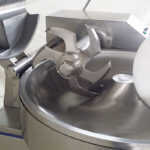
As receitas mais tradicionais costumam usar entre 20% e 30% de gordura no produto, ou seja, para 800g de carne acrescentam aproximadamente 200g de gordura adicional. Usei bem menos do que isso, mas quanto mais gordura usar mais delicada e macia a salsicha ficará. Muito pouca gordura tende a criar um produto mais denso, seco. A receita que fiz é bastante simples e é uma salsicha natural, sem aditivos, sem conservantes e sem corantes.
O pernil que adquiri pesava 2150 gramas e após removido o osso, a pele e a gordura externa, ficou com 1140 gramas. Descartei a pele e usei a gordura.
Ingredientes da salsicha caseira natural Bratwurst
Pernil limpo – 1140 g
Gordura – 238 g
Sal – 18g
Leite em pó – 15g
Açúcar – 15g
Pimenta do reino branca – 2g
Páprica picante – 1g
Caldo de legumes caseiro – 200g
Tripa de porco* – 2m
*A tripa pode ter o calibre desejado e ser natural ou de colágeno. Como eu queria fritar e comer com a tripa optei pela natural suina calibre médio. A Bratwurst é feita para ser frita, então a melhor opção pra mim é, de longe, a tripa natural suina ou ovina.
Abaixo uma tabela de referência em porcentagem para facilitar a produção de quantidades diferentes
| Ingrediente | peso(g) | % |
| Pernil | 1140 | 73 |
| Gordura | 238 | 15 |
| Caldo de legumes caseiro | 200 | 12 |
| Total | 1578 | 100 |
Caso seu pernil não tenha gordura suficiente pode adquirir uma peça da barriga do porco(toucinho) e complementar.
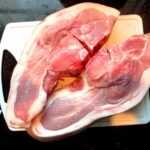
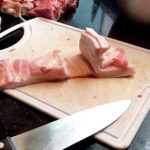
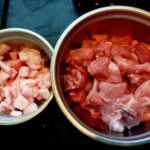
Preparo da salsicha caseira natural Bratwurst
Mantenha sempre tudo gelado, travessas, equipamentos, carnes, gordura e líquidos adicionados à receita deve mestar todos muito gelados. A gordura picada pode estar congelada. Deixe tudo no freezer antes de utilizar. Meça constantemente a temperatura da massa e tente manter sempre abaixo de 15 graus.
Moer e fazer a emulsão carnea
- Pique a carne com uma faca, aproveite para tirar os nervos;
- Pique a gordura, reserve e congele;
- Deixe o caldo de legumes bem gelado ou congele e pique bem fininho, como gelo moído;
- Opcional: Passe a carne no moedor com o disco largo e coloque no freezer por alguns minutos para resfriar novamente;
- Coloque a carne no processador de alimentos montado com a faca de corte e inicie o processamento em potência alta;
- Acrescente todos os ingredientes secos;
- Acrescente a gordura congelada e continue processando;
- Adicione aos poucos o caldo bem gelado ou congelado e picado. É importante acrescentar aos poucos para ir resfriando a massa durante o processamento;
- Meça a temperatura constantemente e caso ultrapasse 15 graus leve imediatamente para o freezer e aguarde alguns minutos até que a temperatura da massa reduza;
- Continue processando até que a misture fique lisa, homogênea, com o aspecto e consistência de uma pasta, como uma pasta de dente, quanto mais lisa, melhor;
- Caso a consistência da massa esteja muito densa, acrescente mais líquido, que pode ser água bem gelada ou gelo picado. Assista ao vídeo da descrição para ver a textura correta.
Embutir e cozinhar a salsicha
- Encha a tripa com a massa, enrole ou amarre com barbante a cada 10 ou 15 centímetros.
- Cozinha em água aquecida a 75 graus por cerca de 20 minutos.
- Frite em uma chapa ou frigideira com um pouco de óleo.
Fiz um vídeo curto que mostra a limpeza da carne, separação do couro e gordura e início do processamento. Não filmei o restante pois tive que parar para resfriar e esqueci de continuar filmando… falha nossa! Na próxima faço completo.
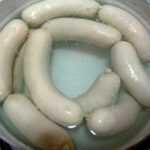
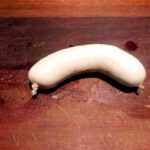
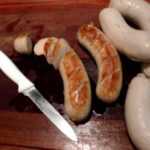
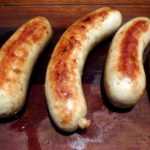
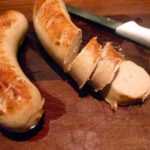




Duas dúvidas: 1) mantendo essa proporção posso fazer qtdade menor? 2) posso congelar? Se sim, após cozida?
Sim, só mantenha a proporção para fazer uma quantidade maior ou menor. Isso, cozinhe e depois congele bem embalada, preferencialmente a vácuo. Vai durar pelo menos 3 meses desta forma.
Bom dia. Quais os legumes são utilizados no caldo de legumes?
Cebola, alho, cenoura, aipo/salsão, salsinha e cebolinha.
Gostaria de comprar salsicha artesanal, sem conservantes ou corantes e já pronta. Você me recomenda alguém em São Paulo, SP?
Oi Felipe, desconheço alguém que produza desta forma em SP. Para a comercialização o uso do sal de cura é obrigatório, teria que tentar algum produtor artesanal que concorde em fazer desta forma.
Boa tarde, minha dúvida é referente ao aspecto visual(cor). Como faço para a salsicha ficar vermelha e não branca.
Igual a essas que estão no blog
https://charcutaria.org/embutidos/como-fazer-salsicha/
Oi Julio, sal de cura e corante carmim para ficar vermelinha. Caso queira mais alaranjada tem que usar o corante urucum líquido.
Urucum em pó
Bom dia Rodrigo.
Obrigado a receita, uma dúvida se eu fizer em um moedor. Qual n° do disco vc indica para moer na segunda vez?
Vamos produzir uma Oktoberfest, um amigo já está com a cerveja pronta. Kkkk
Oi Orlando, moa duas vezes no menor disco possível. Depois misture bem até obter uma massa homogênea.
Bom dia Eduardo. Obrigado pelo excelente site. Eu posso produzir a brattwurst somente com o moedor de carne, sem uso do processador?
Oi Rodrigo. Já fiz vários testes e a textura não fica igual, fica um pouco mais granulada, mas consegue chegar perto. Moa duas vezes a carne bem refrigeda(quase congelada) no disco mais fino que tiver do moedor, misture bem para criar uma boa liga e pode embutir. Se tiver acrescente proteína isolada de soja ou um mix de rendimento para ajudar na emulsão.
Olá ! Um cutter desse seria adequado para uma pequena produção com boa emulsificação ?
Modelo
Skymsen cr 4l
Obrigado 🙂
Oi Fábio, nunca testei esse cutter mas aparentemente sim pelas características tem tudo para gerar uma boa emulsão. Questine o fabricante sobre esse uso em específico, eles podem ter algumas dicas. De modo geral siga os padrões de temperatura baixa, acrescente uma boa quantidade de gelo moído e use um mix emulsificante/rendimento. Salgue a carne um dia antes. Moa uma ou duas vezes e só então processe no cutter. Isso vai ajudar muito no sucesso da emulsão.
200 gr de caldo……não entendi a medida
Me enganei, se for usar o sal deve ser o sal de cura 1. Certo?
Oi Magno. Isso, o certo é usar o sal de cura 1. Vai dar uma durabilidade maior, prevenir o ranço e um sabor típico de curado. Use o sal de cura 1 em conjunto com um antioxidante à base de eritorbato de sódio. O eritorbato é um antioxidante acelerador de cura, ou seja, aumenta a velocidade da reação/conversão do nitrito de sódio. Usando o mínimo recomendável do sal de cura, que é de 2,4g por kg de carne para o sal de cura padrão instacure#1, provavelmente terá zero nitrito residual no produto final. Alguns mix de antioxidante já vem com um acidulante, então o vinho é dispensável para acidificar.
Vamor tentar aprimorar. Grato, abs
Olá. Estou planejando fazer este salsichão pela 2ª vez. A emulsão está funcionando direitinho o sabor está mais intenso, como eu queria, mas gostaria de aumentar o tempo de vida. Comi um com 5 dias que ficou na geladeira achei que tinha um sabor diferente. Pergunto: vale a pena usar um pouco de cura 2, ou talvez somente vinho branco pra deixar mais ácido?Grato
Olá Magno, tudo bem?
Que legal que acertou no sabor! Dá até uma alegria se livrar das salsichas comerciais né não?
Se eu entendi sua pergunta bem, a resposta é não. O sal de cura #2 (nitrato de sódio) é utilizado somente para produtos de cura longa (+ de 30 dias). Como a salsicha é cozida/frita/passada por algum método de cocção, o nitrato de sódio costuma liberar nitrosamina que é danosa ao nosso corpo. Então, se quiser aumentar a vida útil do produto e obter cor e sabor característicos de produtos curados, utilize somente o nitrito (sal de cura #1) para a sua salsicha.
Abraços
Bom dia! 😀
Desculpe a minha ignorância. Gostaria de saber como devo armazenar a salsicha após a ensaca-la. Devo cozinhar e guardar na geladeira ou armazenar sem cozinhar ?
Oi Rafael, cozinhe primeiro e depois refrigere ou congele.
SUA TABELA ESTÁ EQUIVOCADA. 238 GR DE GOSDURAS EQUIVALE A 20,87% E NÃO 15% COMO ESTÁ DESCRITO.
Olá, Maercio. A proporção está calculada sobre o total do peso da massa, incluíndo o líquido. Desta forma 238g(de gordura) de 1578g(peso total) = 15,08% do peso total do produto. Sem o líquido seria 238g(de gordura) de (1378 carne+gordura) = 17,27%.
Excelente a receita, fiz e o aspecto ficou ótimo. Porém perdeu muito o sabor, acho que no cozimento. Alguém tem alguma sugestão?
Oi Magno, que bom que deu certo! É uma receita com condimentação simples e suave, pode incrementar os tmeperos com, por exemplo, algumas ervas, alho e nóz moscada. Isso vai ampliar bem o sabor. Finalize dourando na frigideira com manteiga e azeite que também aumenta bem o sabor e melhora a aparência final. Abraços!
Nobre Schulze,
1) Amadorismo total do calouro da charcutaria: tentei processar a massa em um liquidificador caseiro e quase o queimei; posteriormente, usei uma batedeira e também fiquei no quase (uniformizar a massa).
2) Embuti na tripa do calibre da linguiça, em unidades grandes (imagem anexa);
3) Segui a receita ao pé da letra, mas achei que ficou extremamente condimentada e o sabor nada parecia com o que estamos habituados a comprar. Não esfarinhou e a tripa não se rompeu;
4) Apesar do trabalho e do meio insucesso, gostei da brincadeira!
Oi Eduardo. Obrigado pelo feedback, fico feliz em saber que no geral deu certo. No liquidificador é complicado, a massa é muito densa e o liquidificador não tem força, só velocidade. O ideal é um bom processador de alimentos. Na batedeira é possível e o ideal neste caso é moer duas vezes no disco fino e bater bem a massa depois. Salsicha caseira é um belo desafio! Essa receita é bem diferente das industriais, lembra mais a linguiça branca alemã. É uma receita base bem simples, talvez tenha achado forte a pimenta. Gosto de finalizar na frigideira com azeite, a tripa fica douradinha. Um grande abraço!
Mestre,
Falou tudo: LEMBRA MAIS A LINGUIÇA BRANCA ALEMÃ…
Mais uma vez, obrigado!
Boa noite!!!
Estou iniciando uma produção de linguiças, mas tenho interesse em produzir salsichão também, sei que vou precisar de bateria, então, qual batedeira ou processador que vc me indica pra comprar?
boa noite caso use carne bovina somente qual seria a parte
recomendada
Pode usar qualquer parte, o importante é balancear a quantidade de proteína e gordura, sempre acrescente entre 20% e 30% de gordura rígida, que pode ser de origem bovina e/ou suína. A carne bovina deixará a salsicha mais escura e com sabor mais forte.
Amigo, me desculpa a ignorância, mas qual seria a tripa ideal de se utilizar para que a salsicha artesanal fique com um diâmetro parecido com a salsicha comprada?
Oi Jader, essa salsicha tipo bratwurst alemã da receita é mais espessa, foi feita com tripa calibre 32mm. Salsichas menores de supermercado, tipo hotdog, geralmente usam tripas bem mais finas, calibre 19mm a 22mm.
Bom dia. Como se consegue chegar na cor branca das salsichas alemãs? Seria o leite adicionado? Tanto a carne de porco quanto a de vitela não são brancas. Obrigado.
O leite em pó não interfere na coloração, apenas auxilia na criação de uma boa emulsão, que é bem difícil com equipamentos caseiros. Pelo que sei as weisswursts não tem só vitela, tem proporções de carne suína, vitela, gordura e algumas tem carne de aves também. Depende da região, tradição e receita. Não há adição de corantes, agentes de cura e fixadores de cor. Nessa receita, por exemplo, usei só pernil e a salsicha ficou bem clara, se jogasse salsinha picada ficaria igual à weisswurst alemã.
Parabéns pela publicações, uma leitura fácil e bem objetiva, excelentes dicas para quem gosta de preparar seus próprios embutidos principalmente sem usar aditivos químicos e utilizando equipamentos caseiros.